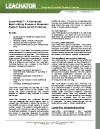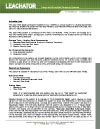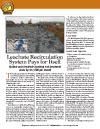- More effective than any other recirculation method
- Completely automated – best investment for the long term
- Uses subsurface irrigation approach for all weather application
- Even wetting without saturation
- Dramatically reduces or eliminates trucking and treating costs
- Significant increase in gas production
The Leach-Rite system is a unique approach to leachate recirculation. Since we have a lot of experience in pumping systems, when recirculation became a hot topic, we started looking at how it was being done, what the problems were and how me might do it better.
Vertical wells and horizontal slotted pipe both have a common problem. They saturate the area around the pipe or well and the leachate channelizes and goes straight back down to the sump. You are simply churning the leachate. This approach also limits the area where you can recirculate. If your pipes are too close to the edge of the cell, breakouts will occur. Between channelizing and breakouts, slope stability can become an issue.
We designed a system that uses subsurface irrigation techniques. Irrigation tubing with emitters produces metered dispersal and very even wetting. The tubing has emitters every two feet and each emitter outputs .65 gallons per hour. The tubing is buried in contact with the trash and below the cap. We set the tubing up in zones and alternate doses to the zones. For example, in a six zones system, we would dose zone 1,3,5 then zones 2,4, and 6. This allows the Leach-Rite system to run fully automated, 24/7, without saturation.
We need a reservoir such as a lagoon or tank and install the system pump at that location. The pump, hydraulic solenoid unit and zone manifold unit are all controlled from a single panel. A programmable controller allows us to set the length of time each zone is dosed.
The system is designed for the volume you want to recirculate and the area available for the emitter field. We have designed systems from as little as 1500 gallons per day up to 30,000 gallons per day.




